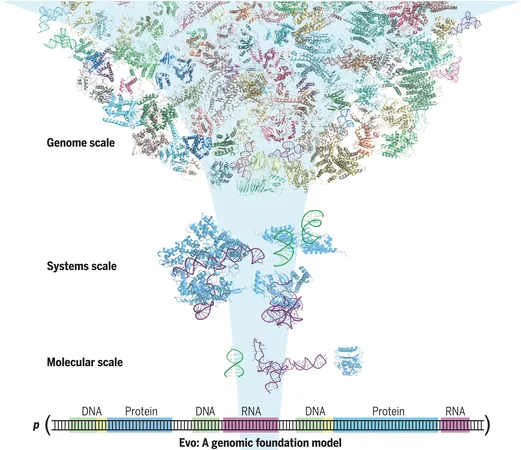
Groundbreaking Breakthrough: Scientists Create Synthetic Genes That Revolutionize Tissue Building!
2024-11-06
Author: Amelia
Introduction
In a remarkable fusion of biology and engineering, researchers from the UCLA Samueli School of Engineering and the University of Rome Tor Vergata have successfully engineered synthetic genes that replicate the natural functioning of genes in living cells. This innovative development could transform the way complex biomolecular materials are constructed, setting the stage for advancements in both synthetic biology and medicine.
Mechanism of Synthetic Genes
The fascinating new synthetic genes enable the construction of intracellular structures through a process akin to assembling modular furniture – think IKEA. Each artificial gene operates like building blocks, capable of creating a variety of structures from the same components. These genes can facilitate not only the assembly of nanoscale tubes using DNA tiles but also enable the breakdown of these designs to craft different materials. The possibilities are endless!
Research Overview
This game-changing study, led by Dr. Elisa Franco, a highly respected professor of mechanical and aerospace engineering and bioengineering at UCLA, was recently published in the prestigious journal *Nature Communications*. The first author of the study, Dr. Daniela Sorrentino, emphasized the potential this research holds for generating complex biomaterials from a finite set of parts by manipulating the timing of molecular instructions for self-assembly.
Expert Insights
Dr. Franco explained the implications of this work, stating, 'Our approach simplifies the process of scaling up the complexity of biomolecular materials by focusing on timing rather than the sheer number of molecules. This presents an exhilarating opportunity to create distinct materials that can spontaneously evolve from a limited set of elements.'
Biological Inspiration
Numerous complex organisms begin their lives from a singular cell, undergoing sequential divisions and differentiations guided by intricate gene cascades. The orchestrated timing of activation in these genes leads to specific biological formations. A prime example of this is seen in fruit flies, where precise gene timing determines body segment formation.
Synthetic Cascade Reconstruction
The researchers drew inspiration from these natural gene cascades to recreate them in the lab. Co-author Dr. Francesco Ricci, a chemical science professor at the University of Rome Tor Vergata, mentioned, 'By mimicking these cascades, we can manipulate the timing of synthetic gene activation to control not just formation but also disassembly of novel materials.'
Experimental Techniques
The scientists utilized innovative DNA blocks composed of a few synthetic DNA strands, mixed in a solution that allowed for interactive formation of micron-sized tubular structures. Their findings revealed that these structures could only emerge in the presence of specific RNA molecules that function as triggers, and can just as easily be disassembled by other RNA triggers.
Controlled Gene Activation
To achieve precise control over this synthesis and disassembly, the team programmed various synthetic genes to produce these RNA triggers at specific time intervals. By creating a synthetic genetic cascade inspired by natural processes, they succeeded in dictating when and how certain DNA structures are formed or disassembled, along with specific properties associated with these structures.
Broader Applications
'Our method is not confined to DNA-based systems,' Dr. Sorrentino noted. 'It can be applied to other materials and systems reliant on the timing of biochemical signals, enabling us to ascribe different functionalities to the same components. This has profound implications for synthetic biology and prospects in the medical field.'
Future Implications
Such advancements could herald a new era in biomanufacturing and therapeutic applications, opening doors to custom-designed biomaterials for drug delivery, tissue engineering, and regenerative medicine that were once simply dreams.
Conclusion
Stay tuned for more updates as these pioneering researchers continue to pave the way for inventive breakthroughs in synthetic biology!









 Brasil (PT)
Brasil (PT)
 Canada (EN)
Canada (EN)
 Chile (ES)
Chile (ES)
 España (ES)
España (ES)
 France (FR)
France (FR)
 Hong Kong (EN)
Hong Kong (EN)
 Italia (IT)
Italia (IT)
 日本 (JA)
日本 (JA)
 Magyarország (HU)
Magyarország (HU)
 Norge (NO)
Norge (NO)
 Polska (PL)
Polska (PL)
 Schweiz (DE)
Schweiz (DE)
 Singapore (EN)
Singapore (EN)
 Sverige (SV)
Sverige (SV)
 Suomi (FI)
Suomi (FI)
 Türkiye (TR)
Türkiye (TR)